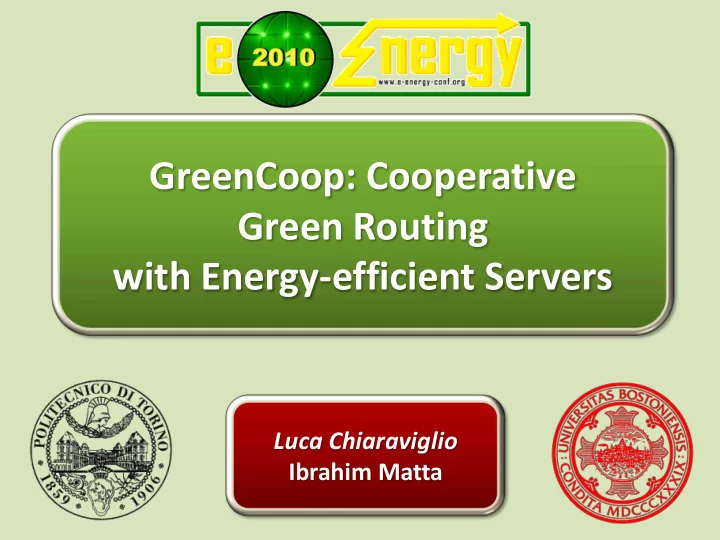

GreenCoop: Cooperative Green Routing with Energy-efficient Servers Luca Chiaraviglio Ibrahim Matta
Motivations Internet Service Providers (ISP) are becoming sensitive to reducing the power consumption of their infrastructure - increasing energy costs - new business opportunities that can be realized by “ going green ” , Also Content Providers (CP) are faced with energy issues - constant increase in the number of users - need to reducing the energy consumption of both server farms and cooling systems.
Previous Work Min set of routers and links to minimize ISP ISP Impact on CP power consumption, given the traffic demand power consumption? and QoS requirements. Min set of resources to minimize CP power CP Impact on ISP consumption, given the variation of electricity , power consumption? prices, renewable sources, users constraints,... ISP Impact on total power ISP and CP cooperation to minimize consumption? CP users delay.
Our Approach ISP CP Cooperation to reduce , overall power consumption Admissible QoS for users
Assumptions • We consider the case of one CP and one ISP. • The ISP is the owner of a network infrastructure. • The CP manages a set of servers, connected to the ISP network. , • Users ask for CP’s resources , under QoS constraints. • Each user can be potentially served by any of the servers of the CP, since the resources are replicated over the CP infrastructure.
GreenCoop Model Minimize CP Power Consumption ISP Power Consumption CP ISP Subject to • Source Destination Traffic • Traffic demands are split is split over the set of paths. over the set of servers • Connectivity Constraint. Shared • Maximum Server Load. • Maximum Link Utilization. Information • Variation of electricity • Maximum Admissible prices. Delay.
System Parameters • We use the ISP backbone topologies obtained from RocketFuel. • We pre-compute up to two disjoint paths for each source- destination pair. • Links can be utilized up to 50% of their capacity. , • CP infrastructure is composed by 15 servers, placed in the largest cities. • Traffic demand of clients is modeled according to a Pareto distribution.
Power Consumption Model Routers, Servers Links Power Power , , 0 max Load 0 max Load Static Power + Dynamic Power Dynamic Power Dynamic link power depends also on the number of amplifiers. For each link, we randomly assign the number of amplifiers (up to 5). , We introduce a 50% random variation of the servers power consumption to model energy price fluctuation.
Power Saving vs Traffic Variation Minimum traffic demand [Mbps]
Power Objective Variation SprintLink Exodus Tiscali Ebone
Maximum Delay Variation Maximum admissible delay [s]
Impact of Servers Placement Minimum traffic demand [Mbps]
Conclusions Energy-aware cooperative design - Minimize overall power consumption between an ISP and a CP - Huge power savings compared to classical models - Common objective function is crucial - Impact of servers placement on the total power consumption Next Steps - Distributed Algorithms to limit the shared information - Cooperation of multiple CPs - Impact of virtualization and colocation of servers
Questions?
A Dual Decomposition Approach - GreenCoop can be split between the ISP and the CP - Iteration until convergence - Implementation requires a Trusted Server (TS) ISP CP Lagrange 2 Multipliers Estimated Demand Real Demand 1 1 Real Delay Estimated Delay TS
Discussion Advantages - the CP does NOT know: ISP topology, link capacity, power consumption of ISP devices, routes for traffic demand - the ISP does NOT know: server load, server capacity, CP power consumption - The distributed problems are smaller than GreenCoop and can be solved in parallel Ongoing Work - Impact of Lagrange Multipliers on convergence time - Optimal solution guaranteed for convex power functions.
Parameters Tuning Step Size Rule for Lagrange Multipliers Update , Iteration K
Thank you!
Recommend
More recommend